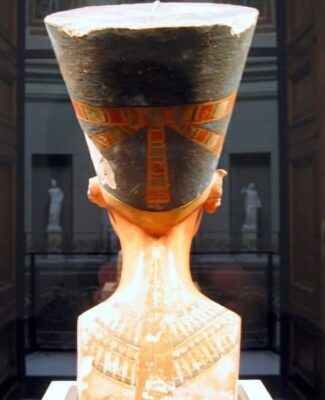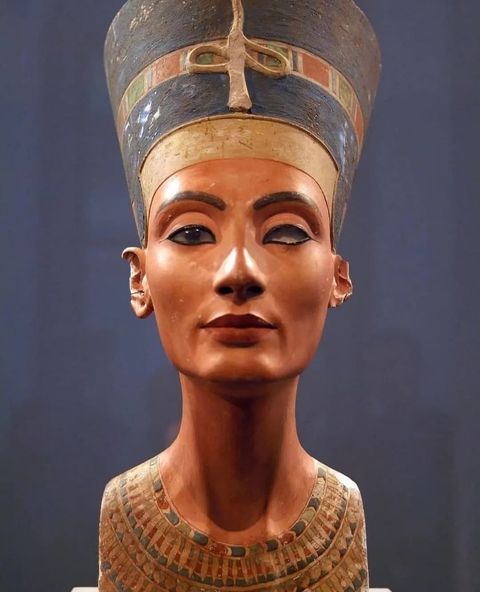The Nefertiti Bust, an iconic sculpture from ancient Egypt, continues to captivate the world with its timeless allure and intricate craftsmanship. Created in 1345 BCE, this masterpiece immortalizes Queen Nefertiti, the powerful royal wife of Pharaoh Akhenaten, and serves as a symbol of beauty, elegance, and the artistry of the Amarna period. Follow archeology.dulichvn.net to discover many hidden mysteries that have yet to be discovered.

The History Behind the Nefertiti Bust
Discovery in Amarna
The Nefertiti Bust was unearthed in 1912 by German archaeologist Ludwig Borchardt during excavations in Amarna, Egypt. Found in the workshop of the sculptor Thutmose, the limestone and stucco bust showcased the artistic finesse of the era, highlighting the queen’s delicate features and regal presence.
Craftsmanship and Realism
The bust’s realism is a testament to the exceptional skills of ancient Egyptian artisans. From the subtle contours of Nefertiti’s face to the vibrant colors adorning the sculpture, every detail was meticulously crafted to reflect her grace and authority.
A Symbol of an Era
As one of the most iconic representations of the Amarna period, the bust not only honors Nefertiti’s legacy but also encapsulates the cultural and religious shifts of her time, particularly the revolutionary changes initiated by her husband, Akhenaten.

The Controversy Surrounding Its Ownership
How the Bust Left Egypt
The Nefertiti Bust was transported to Germany shortly after its discovery, sparking ongoing debates about the circumstances under which it left Egypt. Historical documents suggest that Borchardt may have deliberately underplayed its significance to secure its removal.
Calls for Repatriation
Today, the bust resides in the Neues Museum in Berlin, but Egypt has consistently demanded its return, arguing that it was taken under questionable circumstances. The debate over the artifact’s rightful home is emblematic of broader issues surrounding cultural heritage and artifact repatriation.
A Controversial Icon
While admired globally for its beauty, the Nefertiti Bust is also a symbol of contested history. Its presence in Germany continues to provoke discussions about ethics, colonialism, and the responsibility of museums in preserving and sharing cultural heritage.

The Artistic Significance of the Nefertiti Bust
Timeless Beauty
The bust is celebrated for its harmonious proportions, elegant features, and vivid color palette. Despite being over 3,000 years old, its allure remains undiminished, inspiring countless artists and historians.
Symbolism in Art
Nefertiti’s iconic headdress, adorned with intricate patterns, and her serene expression embody the ideals of ancient Egyptian aesthetics. The sculpture also symbolizes the power and influence of women in royal circles.
Legacy and Inspiration
As a masterpiece of ancient art, the Nefertiti Bust continues to inspire admiration and scholarly research. It bridges the past and present, serving as a reminder of humanity’s enduring quest for beauty and excellence.
See more: The Salt Man: 1,700 Years Old and a Fascinating Discovery in Iran
Conclusion: A Legacy of Beauty and Debate
The Nefertiti Bust is more than a stunning artifact; it is a profound symbol of ancient Egyptian artistry and the complex narratives surrounding cultural heritage. Whether appreciated for its artistic perfection or examined through the lens of historical controversy, the bust remains one of the world’s most cherished and debated treasures.


CÁC TIN KHÁC
Mark Twain & Olivia Langdon: A 36-Year Love Story Filled with Laughter and Devotion
The Tollund Man: A 2,400-Year-Old Mystery Preserved in a Danish Bog
Skara Brae: Scotland’s Hidden Neolithic Village
Porta Nigra: The Hidden Depths of Trier’s Iconic Roman Gate